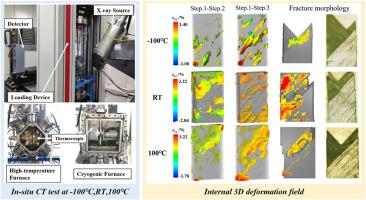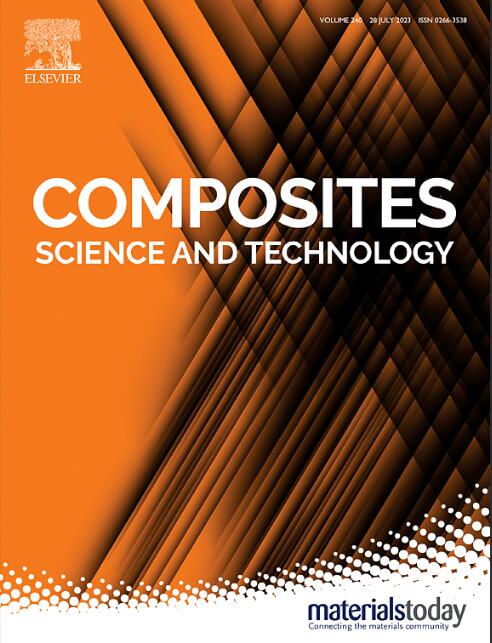Internal shear damage evolution of CFRP laminates ranging from −100 °C to 100 °C using in-situ X-ray computed tomography
IF 8.3
1区 材料科学
Q1 MATERIALS SCIENCE, COMPOSITES
引用次数: 0
Abstract
Carbon Fiber Reinforced Polymer (CFRP) composites have been widely used in aerospace due to their high specific stiffness, strength, and fatigue properties. However, the ambient temperature significantly influences CFRP's mechanical properties and damage evolution, deriving from the temperature effect on the microstructural behavior and the mesoscopic damage evolution. In this study, the temperature-dependent in-plane shear failure behavior of CFRP composites was investigated. In-situ X-ray Computed tomography (CT) tensile experiments of laminates ([45°/-45°]2s) at RT, −100 °C, and 100 °C were carried out to study the in-plane shear failure mechanisms. The 3D fracture morphology was extracted with internal damage evolution process estimated and quantified. The in-situ 3D deformation fields of critical regions were acquired using the Digital Volume Correlation (DVC) method. The effect of temperature on strain field and the correlation between the high-strain region and the fracture location were analyzed. The results revealed the temperature correlations and failure mechanisms of CFRP's mechanical characteristics and internal damage evolution process. Compared to room temperature (RT), the delamination damage area of the sample increased by 80 % at 100 °C. Meanwhile, the shear modulus of CFRP decreases by 78.4 % from −100 °C to 100 °C, and the fracture strain increases by 95 % from RT to 100 °C. The DVC results indicated a dispersion of high-strain regions at −100 °C, reflecting the brittle damage characteristics, while an extensive ductile deformation region was captured at 100 °C. Fiber-matrix debonding is the dominant failure mode of composites under shear loading, whereas significant matrix cracking was observed at −100 °C and partial fiber pullout occurred at 100 °C.

利用原位 X 射线计算机断层扫描分析 -100 ℃ 至 100 ℃ CFRP 层压板的内部剪切损伤演变情况
碳纤维增强聚合物(CFRP)复合材料具有很高的比刚度、强度和疲劳性能,因此被广泛应用于航空航天领域。然而,环境温度对 CFRP 的机械性能和损伤演化有很大影响,这源于温度对微观结构行为和中观损伤演化的影响。本研究调查了 CFRP 复合材料随温度变化的面内剪切破坏行为。为了研究面内剪切破坏机理,研究人员对层压板([45°/-45°]2s)在 RT、-100 ℃ 和 100 ℃ 下进行了原位 X 射线计算机断层扫描(CT)拉伸实验。提取了三维断裂形态,并对内部损伤演变过程进行了估计和量化。使用数字体积相关(DVC)方法获取了临界区域的原位三维变形场。分析了温度对应变场的影响以及高应变区域与断裂位置之间的相关性。结果揭示了 CFRP 机械特性和内部损伤演变过程的温度相关性和破坏机制。与室温(RT)相比,100 °C时样品的分层损伤面积增加了80%。同时,从-100 °C到100 °C,CFRP的剪切模量降低了78.4%,断裂应变从室温到100 °C增加了95%。DVC 结果表明,在-100 °C时,高应变区域分散,反映了脆性破坏特征,而在100 °C时,则捕捉到了广泛的韧性变形区域。纤维-基体脱粘是复合材料在剪切加载下的主要破坏模式,而在-100 °C时观察到明显的基体开裂,100 °C时出现部分纤维拉断。
本文章由计算机程序翻译,如有差异,请以英文原文为准。
求助全文
约1分钟内获得全文
求助全文
来源期刊

Composites Science and Technology
工程技术-材料科学:复合
CiteScore
16.20
自引率
9.90%
发文量
611
审稿时长
33 days
期刊介绍:
Composites Science and Technology publishes refereed original articles on the fundamental and applied science of engineering composites. The focus of this journal is on polymeric matrix composites with reinforcements/fillers ranging from nano- to macro-scale. CSTE encourages manuscripts reporting unique, innovative contributions to the physics, chemistry, materials science and applied mechanics aspects of advanced composites.
Besides traditional fiber reinforced composites, novel composites with significant potential for engineering applications are encouraged.
 求助内容:
求助内容: 应助结果提醒方式:
应助结果提醒方式:


